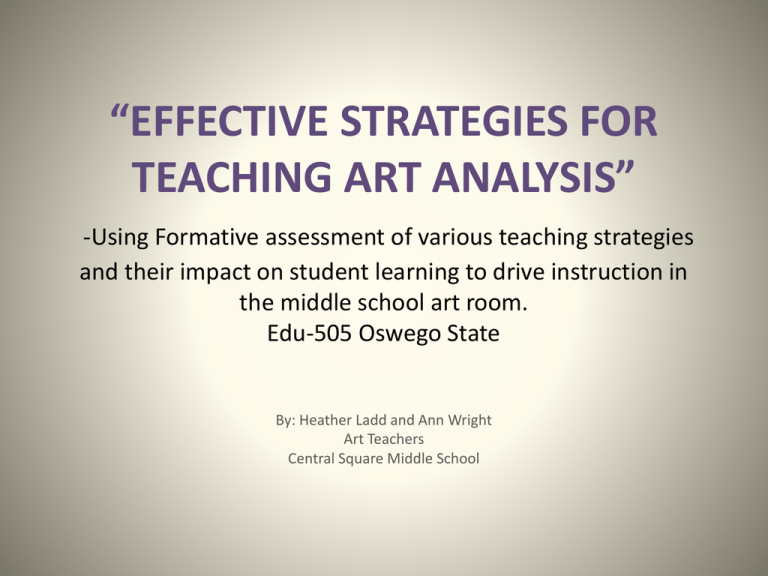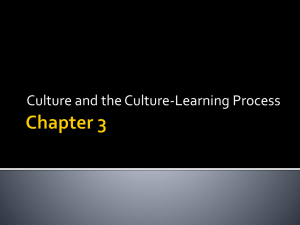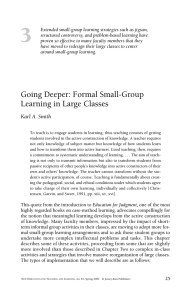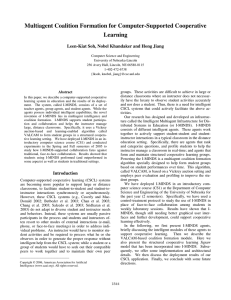Effective Stratagies for Teaching Art Analysis
advertisement

“EFFECTIVE STRATEGIES FOR TEACHING ART ANALYSIS” -Using Formative assessment of various teaching strategies and their impact on student learning to drive instruction in the middle school art room. Edu-505 Oswego State By: Heather Ladd and Ann Wright Art Teachers Central Square Middle School Our project is born: Q.-How can we better teach these standards to our students? Visual Art Standard 3: Responding to and Analyzing Works of Art Students will respond critically to a variety of works in the arts, connecting the individual work to other works and to other aspects of human endeavor and thought. CCLS: Common Core Learning Standards Supported by this project: RS #1,2,3,4,5,7,9 and 10 WS #1b,2b,2d,4,9 and 10 Visual Literacy “The problem” L.-”It’s a boy at Christmas. And he’s getting a present, only the present is from “freaky” thing that Santa is using. I don’t think I like it by the way” SG.- “ It’s the Matrix. No, It’s the Return of the Jedi, you know , like the movie. The eyes are bulging like Barbie. Why does he have a crew cut? What are the star things? It’s kind of freaking me out!” Visual Literacy “Using the Language of Art” D. –”It’s an interior space, a living room. There is a child in the foreground, Christmas tree in the background, and a fireplace in the middle ground”. P. – “The path of the robots arm creates a path for the viewers eye to follow.” A. – “The form of the metal arm makes your eye follow it across the painting.” Past tries: Searching for a clear concise kid friendly format that students can use to organize their new Art Language. Current Art Analysis Format Setting up the project: We separated the 16 classes into four groups with 2 classes being instructed in each of the four instructional strategies listed below (Table groups are ‘stacked ‘ by Lexile scores and students behaviors) • Class A-Whole group- Teacher Directed Instruction for all lessons with little /no teacher intervention. (Unless specifically asked for by student) • Class B-Whole group- Teacher Directed Instruction combined with 1:1 continuous redirection and re-teaching. • Class C- Small group- “Heads together” Cooperative Learning model. • Class D- Small group-“Jigsaw”- Cooperative Learning model“Expert Training Groups”. The Process: Data collection Parameters: • Data collection -analyzed 5 times over the course of the project. • A total number of 400+ 7th & 8th grade students were included in the sampling. • Initial data (baseline data-pre test) without any prior instruction. • Lessons were scripted so that both teachers were using the same language and process • Teaching strategies were implemented 3 times. • Final data collection was given in the form of a quiz. • All data would be gathered entered into an Excel spread sheet and analyzed for student / whole class growth. • Final Data Analysis occurred at the end of the project. We compared and contrasted the individual class growth charts with reference to the type of instructional practice the class received. Compiling the data The Data Group D – “Jigsaw” Cooperative Learning Strategy– ‘Expert training.’ • Growth Score: 287-lowest growth score. • Expert training -created only a single person in each group who knew a specific part of the process. • Students did not remember what they had learned from the session to session. • Students did not work well in both “Expert” and table. • The actual learning process took twice as long to complete. • It takes longer to “ figure out” the process with their peers than to have the teacher lead them through the process. Group B-Teacher directed lesson with teacher circulating and intervening whenever she sees the need. • Growth Score: 338 • *This is the strategy that both Art teachers employ most often and feel most comfortable with. • Initially this class seemed to have the greatest amount of growth from the Pre-test to the first round of grading. • As time progressed the gains became less and less evident. • The final data collection proved that this strategy doesn’t generate greatest learning. Group A-Teacher directed with minimal 1:1 instruction • Growth Score: 597 • Teachers instructed the process of art Analysis then students worked through the process. • Teachers only intervened when a student(s) directly asked for help. • It was very difficult not to intervene when we observed a student struggling. • *Frequently, and as the project continued, this model ended up looking like peer or group work as the students initiated working together to better understand, compare and confirm their answers. Group C-Heads Together Cooperative Learning Strategy • Growth Score: 626 -highest growth score • Results 3 times the overall growth of the lowest group. • Teacher circulated encouraging all students to be vested. • Initially students were not too willing to work with their groups but most groups worked better and better together as the project continued. Final percentages and kid quotes Group D(Jigsaw) Score 287- “I didn’t like the groups because some people didn’t know it well and other people wouldn’t help you if you needed it. I think if the teacher teaches it you learn it better.” Group B (Teacher directed) Score 338 - “I liked the way she teached it because she taught each part at different times –not all at once so we got into depth more with each part of the art analysis.” Group A-(Teacher directed minimal intervention) Score 597 “I think it was easy for us to be able to take our own responsibility only asking for your help when we needed it.” Group C –(Heads together) Score 626 “It was hard but it becomes easier after a while.” “Issues” of note •Classes are ‘stacked’–due to scheduling •Smaller classes had more difficult time working together due to the make up of the class. •Having classes every other day makes this process difficult. Students did not retain information well. •Student absences, snow days, and shortened class periods became an issue-Students absent for pre or final quiz not represented in growth scores. Confirmation from text: “…sometimes less is more-when students were given only the minimum amount of support to get them unstuck and to make progress….they learned more and retained their learning longer than those given full solutions.” “…those given the complete solutions had the opportunity for learning taken away from them.” Embedded Formative Assessment –Dylan Wiliam How it will effect our future teaching practices: More specifically: How will it change our teaching?AW- “Personally, I need to back off and let my students struggle more –they need to ask each other for help through difficult concepts.” “I also need to make sure students work together whether or not they want to.” HL – “I am going to use more “Heads together” when working through problems.” “ I am going to back off and let students struggle and give them just enough information to ‘find’ the answer...” Now it’s your turn: “I and the Village” 1911 By: Marc Chagall











